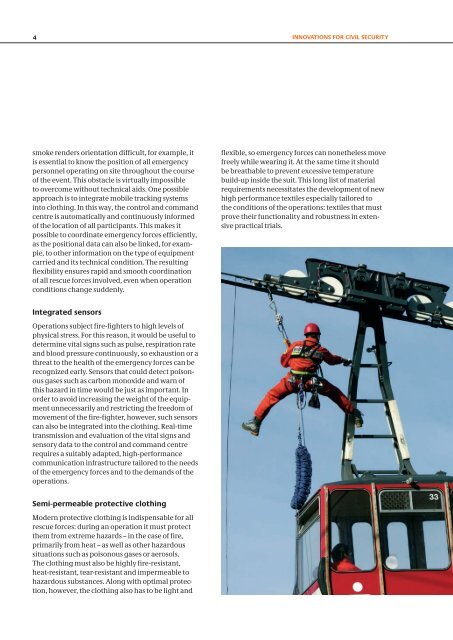Research for Civil Security
Research for Civil Security
Research for Civil Security
- No tags were found...
Create successful ePaper yourself
Turn your PDF publications into a flip-book with our unique Google optimized e-Paper software.
4 INNOvatIONS FOR CIvIl SECuRItysmoke renders orientation difficult, <strong>for</strong> example, itis essential to know the position of all emergencypersonnel operating on site throughout the courseof the event. This obstacle is virtually impossibleto overcome without technical aids. One possibleapproach is to integrate mobile tracking systemsinto clothing. In this way, the control and commandcentre is automatically and continuously in<strong>for</strong>medof the location of all participants. This makes itpossible to coordinate emergency <strong>for</strong>ces efficiently,as the positional data can also be linked, <strong>for</strong> example,to other in<strong>for</strong>mation on the type of equipmentcarried and its technical condition. The resultingflexibility ensures rapid and smooth coordinationof all rescue <strong>for</strong>ces involved, even when operationconditions change suddenly.flexible, so emergency <strong>for</strong>ces can nonetheless movefreely while wearing it. At the same time it shouldbe breathable to prevent excessive temperaturebuild-up inside the suit. This long list of materialrequirements necessitates the development of newhigh per<strong>for</strong>mance textiles especially tailored tothe conditions of the operations: textiles that mustprove their functionality and robustness in extensivepractical trials.Integrated sensorsOperations subject fire-fighters to high levels ofphysical stress. For this reason, it would be useful todetermine vital signs such as pulse, respiration rateand blood pressure continuously, so exhaustion or athreat to the health of the emergency <strong>for</strong>ces can berecognized early. Sensors that could detect poisonousgases such as carbon monoxide and warn ofthis hazard in time would be just as important. Inorder to avoid increasing the weight of the equipmentunnecessarily and restricting the freedom ofmovement of the fire-fighter, however, such sensorscan also be integrated into the clothing. Real-timetransmission and evaluation of the vital signs andsensory data to the control and command centrerequires a suitably adapted, high-per<strong>for</strong>mancecommunication infrastructure tailored to the needsof the emergency <strong>for</strong>ces and to the demands of theoperations.Semi-permeable protective clothingModern protective clothing is indispensable <strong>for</strong> allrescue <strong>for</strong>ces: during an operation it must protectthem from extreme hazards – in the case of fire,primarily from heat – as well as other hazardoussituations such as poisonous gases or aerosols.The clothing must also be highly fire-resistant,heat-resistant, tear-resistant and impermeable tohazardous substances. Along with optimal protection,however, the clothing also has to be light and
















